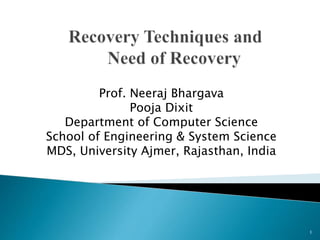
Recovery Techniques and Need of Recovery
- 1. Prof. Neeraj Bhargava Pooja Dixit Department of Computer Science School of Engineering & System Science MDS, University Ajmer, Rajasthan, India 1
- 2. Introduction… What & Why… Types… Failure… Recovery… Key Features… Problems… Conclusion… 2
- 3. “Recovery” is the process of restoring the database to the most recent consistent state that exits just before the Failure. Recovery techniques are heavily dependent upon the existence of a special file known as a system log. It contains information about the start and end of each transaction and any updates which occur in the transaction. 3
- 4. In computing, data recovery is a process of retrieving inaccessible, lost, corrupted, damaged or formatted data from secondary storage, removable media or files, when the data stored in them cannot be accessed in a normal way. The most common data recovery scenario involves an operating system failure, malfunction of a storage device, logical failure of storage devices, accidental damage or deletion, etc. 4
- 5. After all when data is starting to lost there are some techniques introduced to retrieve that data back safely. There are 3 states of database Recovery: Pre-Condition:- At any given point in the time the database is in consistent state. Condition:- Occurs some kind of system failure. Post-condition:- Restore the database to the consistent state that existed before the failure. Note :- Before we discuss about Recovery first we need to know about why Recovery is needed ? It is need because of failure’s. So we first Understand about failure… 5
- 6. In Computer terminology “Failure “ is the state when any process is being “Interrupted” and cant produce an desired result’s. In concern with DBMS Failure can be classified by :– Transaction Failure System crash Disk Failure 6
- 7. 7
- 8. The transaction failure occurs when it fails to execute or when it reaches a point from where it can't go any further. If a few transaction or process is hurt, then this is called as transaction failure. Reasons for a transaction failure could be - ◦ Logical errors: If a transaction cannot complete due to some code error or an internal error condition, then the logical error occurs. ◦ Syntax error: It occurs where the DBMS itself terminates an active transaction because the database system is not able to execute it. For example, The system aborts an active transaction, in case of deadlock or resource unavailability. 8
- 9. Simply we can say that System failure can occur due to power failure or other hardware or software failure. In computing, a crash, or system crash, occurs when a computer program such as a software application or an operating system stops functioning properly and exits. 9
- 10. Disk failure occurs due to the formation of bad sectors, disk head crash, and unreachability to the disk or any other failure, which destroy all or part of disk storage. A hard disk failure may occur in the course of normal operation, or due to an external factor such as exposure to fire or water or high magnetic fields, or suffering a sharp impact or environmental contamination, which can lead to a head crash. 10
- 11. “Recovery” is the process of restoring the database to the most recent consistent state that exits just before the Failure. 11
- 12. There are basically 2 types Recovery techniques i.e. 1) LOG BASED 2) CONCURRENT TRANSACTION 12
- 13. Log is a sequence of records, which maintains the records of actions performed by a transaction. In this method LOG of each transaction is maintain in some Stable Storage. In case of any Failure occurs it can be recover from recover Station. LOG:- Every log will have an information like what transaction is being executed , which value have been modified. 13
- 14. Write to a log file before writing to database Enter log records Transaction states: Start, Abort, Commit Example log file DB(A = 1000,B = 2000) Transaction Log File T1 start <T1,Start> Read(A) A = A-100 Write(A) <T1,A,1000,900> T1 end <T1, Commit> T2 start <T2, Start> Read(B) B=B+100 Write(B) <T2, B, 2000, 2100> T2 end <T2, Commit> 14
- 15. When more than one transaction are being execute parallel the LOG, at Recovery time it would become hard for recovery system to back track all log’s. So to prevent this situation we use “CHECKPOINTS”. These are like Bookmarks , when transaction is executed such chckpnt are marked on that transaction. 15
- 16. Recovery system consults log file when failure occurs Search entries in log file Time depends on number of entries Why redo transactions already written to disk? Introduce checkpoint records into log file Only transactions committed after last checkpoint need to be redone after a failure 16
- 17. The recovery system reads the logs backwards from the end to the last checkpoint. It maintains two lists, an undo-list and a redo- list. If the recovery system sees a log with <Tn, Start> and <Tn, Commit> or just <Tn, Commit>, it puts the transaction in the redo-list. If the recovery system sees a log with <Tn, Start> but no commit or abort log found, it puts the transaction in undo-list. 17
- 18. From the above Description about the Failure & Data Recovery techniques we had focus on Problem i.e the data can be lost for many reasons and sometimes the System cant be helpful for storing data by which many organization can face the data lost , lack of information , corrupt data and many more similar situation’s. 18
- 19. Recovery is an modern methodology that prevent user from crucial data loss problem. There are several techniques that can help and stop the Failure at there own level. The Checkpoint is a term that ensure your progress on data by which in a large dataset the user can start from last “checkpoint”. 19